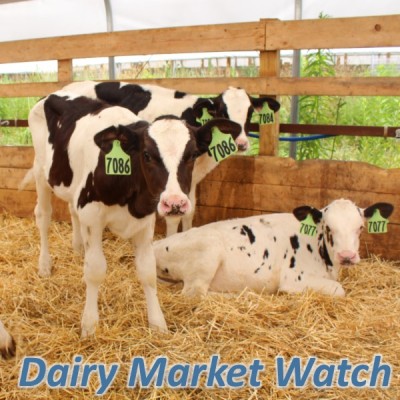Dairy Market Watch - September 2020
Alycia Drwencke, Dairy Management Specialist
Southwest New York Dairy, Livestock and Field Crops Program

Dairy Outlook: September 2020
PennState Extension
This is an excerpt from the originally published Outlook available here: https://extension.psu.edu/dairy-outlook-september-2020
Class III highs are receding, and prices in the short term are normalizing. Unknowns of fall consumer and restaurant demands continue to add volatility to futures markets.
The Mystery of Today's Milk Market Continues
Given the turbulence of the milk markets, and the markets in general, it is hard to predict where things are going with any reasonable sense of assurance. Class III prices have receded from the summer spike which caused most Pennsylvania farms to be impacted by a larger than usual negative Producer Price Differential. Class I and IV milk have improved from the lows of the spring, but are still off the anticipated pace from the end of 2020. Numerous factors continue to influence these futures, but for the time being, it appears both Class III and Class IV are normalizing in the $17/cwt. and $14/cwt. range respectfully for the rest of 2020. The Pennsylvania All Milk Price should stabilize around $19.25/cwt. for the same period if those prices come to fruition.
The Good and Bad of U.S. Dairy Consumption Trends
USDA recently released the 2019 dairy production consumption data per capita. Figure 1 outlines how fluid milk, total milk product (adjusted by milk fat equivalent), and annual U.S. milk production per capita have trended since 1975. No surprise, fluid milk has steadily decreased over the past 45 years, going from roughly 250 lbs. per person in 1975 to only 150 lbs. in 2019. Despite the drop in fluid milk, total dairy consumption has been steadily climbing for the same time. For the same period, average annual U.S. milk production had kept pace with that demand, until the early 2000s. Since then, U.S. production has outpaced per capita consumption. This isn't necessarily a concern, given this data does not reflect any export data for the same time period. When examining the recent trends in commercial disappearance versus milk production, the last two months have seen slightly better disappearance than that months production. However, given the continued influences of changing consumer demands and government interventions, supply and demand will continue to be fragile for the foreseeable future. There are some positive trends from consumer markets that exist beyond the reduced fluid milk and stagnant yogurt trends. Figure 3 takes a closer look at butter and total cheese (American, other than American, and Cottage) for the past twenty years. In that time, per capita consumption has increased nearly 26% for total cheeses (from 32 total pounds to nearly 42.5 lbs) and butter has increased by 38% (going from 4.5 lbs. in 2000 to over 6 lbs. in 2019). Hopefully these trends will continue to improve under the pandemic related shifts in eating patterns by consumers.
Dairy Market Watch 2020 09 (pdf; 2018KB)
Upcoming Events
Crops, Cows & Critters - Southwest New York Dairy, Livestock & Field Crops Newsletter Sponsorship
December 19, 2025
Our two forms of publications feature research-based and timely information from our four specialists, listed to the right, along with local event notifications and Cornell University outreach. This information is provided to participants who range from dairy, livestock, and field crops producers to agricultural suppliers and consultants.
Weekly Email Update: Shared with 625+ households who have signed up with our program.
Monthly Paper Mailer: To reach our stakeholders and farmers who lack internet access, we send out a monthly mailer where your company's logo and contact information would be featured with a mailing list of 330+ households.
If you sponsor our weekly and monthly publications you reach approximately 955 households.
Visit our website to view our newsletters!
2025 Cornell Food Beverage & Animal Feed Manufacturer Survey
December 19, 2025
Industry and Educational Advocates for New York State's Food, Beverage, and Animal Feed Manufacturing industries:
As you know, NYS has a diverse food and beverage manufacturing industry, in both the types of industries that exist and the wide distribution of firms by scale. Many manufacturing firms have strong backward linkages to agricultural production sectors in the state that support both farm-level and downstream food industry firms and consumers. In collaboration with the New York State Department of Agriculture and Markets, a team from Cornell University's Charles H. Dyson School of Applied Economics and Management has recently rolled out the 2025 New York State Food, Beverage, and Animal Feed Manufacturer Survey. The industry will benefit from an updated assessment of the industry that informs private and public investments and opportunities to support firm growth and improved profitability.
Cornell Organic Field Crops & Dairy Conference
March 6, 2026
Waterloo, NY
Farmers, researchers, educators, and agricultural service providers from across the Northeast are invited to the 2026 Cornell Organic Field Crops & Dairy Conference, held Friday, March 6, 2026, from 8:00 a.m. to 4:30 p.m. at the Lux Hotel & Conference Center in Waterloo, N.Y.
Co-hosted by New York Soil Health and Cornell CALS, the annual conference brings together leaders in organic grain, dairy, and livestock systems to share practical tools, new research, and farmer-tested strategies to support resilient and profitable organic production.
Announcements
No announcements at this time.





